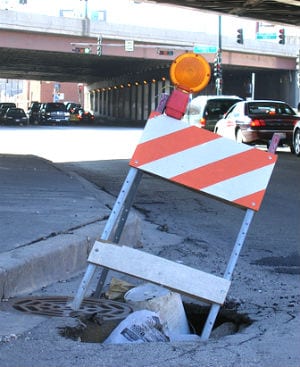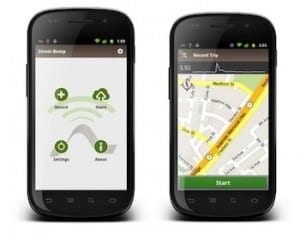 In Boston, potholes, graffiti and other public “trouble spots” used to get fixed like this: a (usually angry) resident called the Public Works department’s 24-hour hotline to file a complaint. Using old enterprise software, the department then determined, based on the location, date, and priority it placed on the nuisance, what crew to send out to make a repair. Ask just about anyone how quickly potholes on their block get repaired and you’ll get a sense for how well the system worked. Both the city and the mayor agreed the system needed an upgrade.
In Boston, potholes, graffiti and other public “trouble spots” used to get fixed like this: a (usually angry) resident called the Public Works department’s 24-hour hotline to file a complaint. Using old enterprise software, the department then determined, based on the location, date, and priority it placed on the nuisance, what crew to send out to make a repair. Ask just about anyone how quickly potholes on their block get repaired and you’ll get a sense for how well the system worked. Both the city and the mayor agreed the system needed an upgrade.
Today, Boston trouble spots are getting fixed a little differently, thanks to a newly formed government office and some high-tech apps that are showing just how transformational smartphones can be for field service issues.
In 2010, the Boston Public Works Department created the Mayor’s Office of New Urban Mechanics, described as a “civic innovation incubator” and singularly focused on developing new ideas to connect the city and its constituents through new technologies — a concept that the city says has yielded fantastic results.
Mobile pothole detector

Street Bump
Case in point: the office has been making headlines recently for Street Bump, a mobile app that can detect potholes by using accelerometer sensors that are already in a driver’s smartphone. When the phone senses that it’s driven over a pothole, it records the location of the hole by using its built-in GPS system, and reports it to the city. The city’s public works department, which is also using the app, is automatically alerted to the problem once enough phones report the pothole, and dispatched at once. No more angry phone calls, emails, or visits to the city offices. (Well, fewer anyway.)
The city’s efforts began in 2009 with an app called Citizen Connect and now also include City Worker, unveiled this year, both of which allow smartphone-wielding Bostonians to report city nuisances via their phones.
“Smartphones present a major new way that people are interacting with the world around them, so it made sense for us to try to provide some channels into governments using smartphones,” said Nigel Jacob, the co-chair of the mayor’s Office of New Urban Mechanics. “We’re all about creating a new channel for the city to connect with people and for enabling those people to connect directly with the workers on the ground that are going to actually deliver the service.”
Putting more smartphones to work
With the Street Bump app, all pothole reports are routed through a workorder management system and sent straight to a work crew, most of which are outfitted with Android-based smartphones. The system works the same way for the Citizen Connect and City Worker apps. Jacob says the field workers have welcomed these new apps and devices with open arms.
“We’ve had strong signals from the Public Works guys that they’re willing to use Android devices,” Jacob said. “The big weighty handhelds and desktops they used to use required them to take special trips back to the office or their trucks. Our idea was that if we can instead adapt our technology to how these guys are already working, we can do a better job of enabling them to gather information, use it more effectively and allow them to get the most out of their workday.”
Broken down, Boston’s concept is actually pretty simple: Let the citizens who are out there every day, all over the city, act as the eyes and ears to find and report issues. The next and critical step, said Chris Osgood, the other co-chair, was putting innovative technology and an effective means of reporting those issues in their hands.
Connecting residents with city workers
“Our aspiration is to connect the city resident and the city worker together,” he said. “A lot of residents look at government as a faceless body. Instead, we want to make sure our city workers hear the voice of our constituents and that the constituents can more visibly see the service work that is getting done at their request in their neighborhood. That bridge is really important and is reinforced through the technical systems we’ve created and the way that we’re rolling out and presenting this suite of apps.”
Jacob and Osgood said there have been over 25,000 total service requests through Citizen Connect since its launch, and that the response has been overwhelmingly positive from both city workers and citizens. So what’s next after technology that senses and reports a pothole without a single call being made?
“We’d like to develop a system where a citizen who reported a pothole can get a photo back of the filled pothole from the city worker who filled it.”
Sort of like a receipt?
“Exactly.”

I would be interesting to know how the Workorder Management System works and how this optimimed the fixing speed of the potholes.
As mentioned in the beginning of the article, the biggest nuisance is the time it takes to resolve the issues. With the app below (which is very good though), you would unfortunately just create more incidents to be fixed and hence require more lead time to be fixed.
Jeroen,
I agree that simply pushing more reports into the system would create greater lead times. However, it sounds like (in theory) this application greatly increases the accuracy of reports. By auto-generating Work Orders only once a certain threshold of reports has been met for a given geo-coded location, they ought to be nearly 100% accurate.
This should save work crews significant time by pointing them directly to the location of the problem via GPS, instead of requiring city workers to find reported problems by accurately interpreting vague locations provided through some other medium.
It’s amazing what’s become possible in the past few years through the ubiquity of smart devices, no?